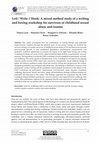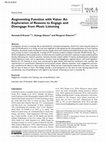Papers by Margaret S Osborne
Music and Synesthesia Abstracts from a Conference in Vienna, scheduled for July 3–5, 2020, 2020

Journal of Clinical Sport Psychology
This cross-sectional study explored athlete responses to the Compassion Motivation and Action Sca... more This cross-sectional study explored athlete responses to the Compassion Motivation and Action Scales Self-Compassion Scale, examining its relationship with well-being. Athlete (N = 207; mean age 27.9 years) scores were consistent with previous population means. Scores on the Compassion Motivation and Action Scales Self-Compassion Scale did not differ between elite and nonelite athletes, nor did they correlate significantly with trait competitiveness. Significant differences emerged based on athlete well-being state, with athletes categorized as “flourishing” scoring higher on the total score and all subscales of the Compassion Motivation and Action Scales Self-Compassion Scale, as compared with those with “moderate mental health” (Cohen’s ds from 0.58 to 0.92). Furthermore, the distress tolerance subscale significantly mediated the relationship between self-compassion intentions and well-being (indirect path: B = 0.034, p < .001). The results suggest that self-compassionate inten...

International Journal of Wellbeing
This article investigates how the combination of writing therapy and embodied empowerment, explor... more This article investigates how the combination of writing therapy and embodied empowerment, explored through the physical sport of non-contact boxing, can facilitate the recovery journeys of women survivors of childhood sexual abuse (CSA) and their move towards post-traumatic growth. It uses established quantitative psychological measurements and qualitative analytical approaches to examine the impact of an eight-week boxing and writing workshop for female survivors of CSA, called Left/Write//Hook (LWH), on participants' recovery journeys. The hypothesis was that the LWH workshops would contribute to participants' recovery and wellbeing. The article reports on the pilot study of the workshops as one aspect of an ongoing research project around LWH which uses concurrent, triangulation mixed methods design to gather and analyze qualitative audiovisual and creative-writing data produced by the women, alongside quantitative psychological assessment data. The findings of qualitative analyses of the participants' creative writing and the quantitative psychological assessments of the impact of the LWH workshops on participants' assertiveness, post-traumatic stress disorder symptoms, wellbeing, depression, anxiety and stress, along with preliminary findings of filmed material are presented and discussed in this article. The findings supported the hypothesis that the LWH workshops helped facilitate participants' recovery journeys and supported their wellbeing. This article offers preliminary support for the argument that the dual approach of written/verbal and embodied creativity can enhance the wellbeing of survivors of sexual abuse and trauma.

The Oxford Handbook of Music Performance, Volume 2
Music performance anxiety (MPA) is a pervasive and frequently debilitating difficulty faced by ma... more Music performance anxiety (MPA) is a pervasive and frequently debilitating difficulty faced by many performers associated with negative impacts on performance quality, psychological distress, deteriorations in confidence, and, at its extreme, disengagement from performing. MPA typically begins early in a musical career and negatively affects performance achievement and career sustainability. Much of the research investigating the vulnerabilities and mechanisms associated with MPA has focused on biological characteristics such as age and gender; psychological characteristics such as trait anxiety, social phobia, and perfectionism; and associated factors such as gender, age, musical genre, and performance context. These factors have been identified as pertinent in predicting and coping with performance anxiety in musicians. This chapter reviews the characteristics and incidence of MPA, and provides a developmental model and treatment modalities, before ending with a summary of practic...
Australian Psychologist, 2022
The Child as Musician, 2015

International Journal of Music Education, 2015
Rates of music participation are low in developed nations. This may be attributed in part to the ... more Rates of music participation are low in developed nations. This may be attributed in part to the failure of school music to engage children sufficiently to motivate them to continue learning and participating in music. We tested the Harmonix program of classroom music education, which is currently being designed to maximize engagement in music learning. The program employs a set of new, harmonically tuned percussion instruments, using cyclical, self-cuing patterns, and hierarchical rhythmic structures that match complexity with ability. Graphical scores reduce cognitive load, and assist students to compose music from the first class. Cooperative learning activities consolidate learning and further stimulate engagement through personal and group expression. Using a combination of timely self-report and objective measurement, we found that student learning and skill acquisition increased over the six-week program while high engagement was maintained. Engagement measures also increased...

Research Studies in Music Education, 2015
This study extends an eight-country mapping exercise (McPherson & O’Neill, 2010; see Research Stu... more This study extends an eight-country mapping exercise (McPherson & O’Neill, 2010; see Research Studies in Music Education issues 2010–2011) to include students’ motivation to study music within the Australian context. It sought to determine whether music learners (students learning an instrument or voice), might be more motivated to study academic subjects at school, and whether gender and socio-economic status (SES) affected student motivation to learn music at school. A total of 2,727 students from grades 5 to 12 completed a questionnaire based on Eccles and Wigfield’s expectancy-value framework. Data collected included: ratings of competence beliefs, interest, importance, usefulness and difficulty for music, English, maths, and science; indications of whether the students were currently learning a musical instrument or voice (music learners); and whether they would like to if given the opportunity. There was an overall significant decline in competence beliefs, interest, importanc...

Performance Enhancement & Health, 2016
Abstract There is an increasing body of evidence that the prevalence of music performance anxiety... more Abstract There is an increasing body of evidence that the prevalence of music performance anxiety (MPA) and perfectionism in populations of adult musicians is high, and that both conditions impact negatively on the psychological health and wellbeing of musicians. There is scant evidence on the origins of these two conditions in student populations. The purpose of this study was to examine the prevalence and developmental trajectory of MPA and perfectionism in a population of school age children. A sample of 526 students (male n = 291; female n = 235) across Grades 5–12 at a private school on the outskirts of Melbourne, Victoria were administered two questionnaires, the Music Performance Anxiety Inventory for Adolescents (MPAI-A; Osborne & Kenny, 2005 ) which measures the somatic, cognitive and behavioural components of MPA, and the Child Multidimensional Perfectionism Scale (C-MPS; DeKryger, 2005 ). The C-MPS measures the multidimensional components of perfectionism in children, such as Concern over Mistakes, Organisation, Parental Expectations, and Doubts about Actions. The correlation between MPA and perfectionism by age showed a consistently strong, positive and highly significant relationship from 10 through to 17 years of age, particularly for Concern over Mistakes. The second significant relationship between MPA and perfectionism applied to gender, with females experiencing a steeper and more intense developmental trajectory than males. The third important finding of the research was that levels of MPA and perfectionism increase with years of experience. This study has implications for teachers and psychologists working with young students of music.

Music Education Research, 2015
We sought to understand the potential for positive non-musical outcomes for economically and soci... more We sought to understand the potential for positive non-musical outcomes for economically and socially disadvantaged primary school students who are involved in instrumental music learning programs. Two schools with students experiencing generational poverty, current or first-generation immigrant or refugee status who were running El-Sistema inspired music programs participated in the study. Ninety-two students in Years 3–6 completed audio-visual assessments of non-verbal reasoning, verbal and mathematical ability, and psychosocial well-being. Comparisons by school and program participation over a period of 12 months, indicate improved non-verbal (visuo-spatial) reasoning, verbal and mathematical skills, and psychosocial well-being for students at School 1. Findings indicate some evidence of positive outcomes for low socio-economic status and socially disadvantaged children who participate in El Sistema-inspired extra-curricular music programs. Given the substantial number of students involved in such programs worldwide, these findings suggest outcomes for disadvantaged students may be improved through music learning opportunities.

Performance Enhancement & Health, 2016
Abstract There is an increasing body of evidence that the prevalence of music performance anxiety... more Abstract There is an increasing body of evidence that the prevalence of music performance anxiety (MPA) and perfectionism in populations of adult musicians is high, and that both conditions impact negatively on the psychological health and wellbeing of musicians. There is scant evidence on the origins of these two conditions in student populations. The purpose of this study was to examine the prevalence and developmental trajectory of MPA and perfectionism in a population of school age children. A sample of 526 students (male n = 291; female n = 235) across Grades 5–12 at a private school on the outskirts of Melbourne, Victoria were administered two questionnaires, the Music Performance Anxiety Inventory for Adolescents (MPAI-A; Osborne & Kenny, 2005 ) which measures the somatic, cognitive and behavioural components of MPA, and the Child Multidimensional Perfectionism Scale (C-MPS; DeKryger, 2005 ). The C-MPS measures the multidimensional components of perfectionism in children, such as Concern over Mistakes, Organisation, Parental Expectations, and Doubts about Actions. The correlation between MPA and perfectionism by age showed a consistently strong, positive and highly significant relationship from 10 through to 17 years of age, particularly for Concern over Mistakes. The second significant relationship between MPA and perfectionism applied to gender, with females experiencing a steeper and more intense developmental trajectory than males. The third important finding of the research was that levels of MPA and perfectionism increase with years of experience. This study has implications for teachers and psychologists working with young students of music.

Music & Science
Investigations of music in everyday life are dominated by a functional perspective, drawn from wo... more Investigations of music in everyday life are dominated by a functional perspective, drawn from work using the theory of Uses and Gratifications. In so doing, we may have neglected to fully appreciate the value people place on music listening. Therefore, the present study considered if, and why, people value music listening and probed instances when they may not want to listen to music in everyday life. A sample of 319 university students residing in Australia (76.50% female, M age = 20.64) completed an online questionnaire, on which they were asked to provide short responses to open-ended questions directly addressing two research questions. Inductive thematic analysis yielded 13 themes synthesizing how participants valued listening to music, such as appreciation, emotion, time and engagement, cognitive factors, and mood regulation. Reasons for not listening to music were summarized by eight themes dominated by interference with activities that required focus or concentration, follo...

Psychology of Music, 2017
This article describes the development of a music practice microanalysis protocol that is based o... more This article describes the development of a music practice microanalysis protocol that is based on the three-phase model of self-regulated learning (i.e., Forethought, Performance, and Self-Reflection). Up until now, most studies on music practice have tended to focus on behavioural aspects. The expanded view presented here outlines a technique for mapping the types of behaviours (actions), cognition (thoughts), and affect (feelings) that can help focus musicians’ practice. To explain the technique, we describe the practice of two first year Bachelor of Music students studying at a prominent university music school who are compared at three time points across one semester as they prepare an étude for a performance exam. These case studies demonstrate two broadly contrasting self-regulated learning profiles of how microanalysis can be used to cue students to think about what they are doing and then reflect critically on the strategies they can use to improve their playing. As a techn...
… of the European Society for the …, 2007
International Journal on Innovations in Online Education

Psychology of Music
The purpose of this study was to explore the effects of using a self-directed practice diary on c... more The purpose of this study was to explore the effects of using a self-directed practice diary on conservatory pianists’ self-regulated learning tendencies. We sought to determine whether the implementation of a self-directed practice diary based on the three-phase model of self-regulated learning would lead students to gradually demonstrate more self-regulated learning tendencies across a semester of practicing, and if the type and quality of their self-regulated learning tendencies varied as a function of performance ability. A marked and consistent improvement in metacognitive monitoring skills was observed across the semester for all seven participants. Variations between lower and higher ability students were most pronounced in the Forethought stage, with higher ability pianists reporting fewer goals and strategies and higher self-motivational beliefs than their lower ability counterparts. In the Performance phase, higher ability students invested more effort in help seeking and ...

Psychology of Music
The way musicians appraise their abilities to succeed in a forthcoming evaluative performance imp... more The way musicians appraise their abilities to succeed in a forthcoming evaluative performance impacts on the range of emotions they will experience. According to Lazarus’ cognitive-motivational-relational theory, emotions may wield powerful consequences depending on whether the performance is interpreted as a threat (high importance/primary appraisal; low coping prospects/secondary appraisal), or challenge (high importance; high coping prospects). Thirty-six Bachelor of Music students at a large University music school completed an adaptation of the Precompetitive Appraisal Measure (PAM) and Competitive State Anxiety Inventory–2R-D twice in relation to their end-of-semester recital: at the start of semester, and within an hour before their recital. Primary and secondary appraisals formed theoretically consistent and reliable evaluations of threat and challenge. Secondary appraisals were significantly lower for students who viewed the performance as a threat. Students who viewed the ...









Uploads
Papers by Margaret S Osborne
Listening to music is a popular leisure activity. Investigations of music in everyday life are dominated by a functional perspective, drawn from work using the theory of Uses and Gratifications. In so doing, we may have neglected to fully appreciate the value people place on music listening. Therefore, the present study considered if, and why, people value music listening and probed instances when they may not want to listen to music in everyday life.
Aims
This study considered if, and why, people value music listening and also probed instances when they may not want to listen to music in everyday life. This research was therefore guided by two questions: (1) How is the value of music listening expressed? and (2) Are there any times/situations when people do not want to listen to music?
Methods
A total of 319 university students residing in Australia (76.50% female, Mean age = 20.64 years) completed an online questionnaire. The majority of the sample considered themselves to be ‘non-musicians’; however, the sample reported listening to an average of three hours of music daily and considered music to be very important in their lives (Mean = 6.14 on a 7-point scale). Participants responded to open-ended questions directly addressing the two research questions and thematic analyses were conducted.
Results
Inductive thematic analysis yielded thirteen themes synthesising how participants valued listening to music, such as appreciation, emotion, time and engagement, cognitive factors and mood regulation. Reasons for not listening to music were summarised by eight themes dominated by interference with activities that required focus or concentration, followed by environmental context, affective responses, music engagement and inversely, a preference for silence or other auditory stimuli. Fifteen percent of participants stated there was never a time they did not want to listen to music.
Conclusion and Implications
By taking a macroscopic approach with the present research, we posit that Uses and Gratifications theory can be interpreted as inhabiting one of two branches of an axiological theory of value, with aesthetics on the other branch. Thus, while Uses and Gratifications is an appropriate framework to understand music listening from the perspective of ‘listening as valued as a means to an end’, it may be less able to interpret music listening’s worth when identified as ‘a means in and of itself’. It is worth noting, however, that within the axiological theory of value the two branches are not mutually exclusive; indeed, the distinction between means and ends is a fuzzy line. We posit that forms of musical engagement, such as music listening, can fall within this intersection.